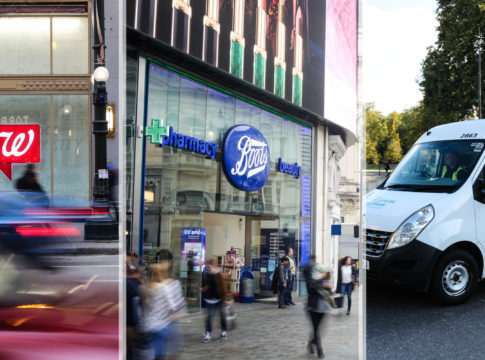Walgreens Boots Alliance, Inc. (Nasdaq: WBA) today announced financial results for the third quarter of fiscal 2020, which ended May 31, 2020.
Executive Vice Chairman and CEO Stefano Pessina said, “Prior to the pandemic our financial performance for fiscal 2020 was on track with our expectations. However, this unprecedented global crisis led to a loss in the quarter as stay-at-home orders affected all of our markets. I’m very proud of how all of our teams mobilized and adapted to deliver essential services in our communities across the world. Shopping patterns are evolving more rapidly than ever as consumers further embrace digital options, spurring us to accelerate our ongoing investments in digital transformation and neighborhood health destinations. This includes our two recent announcements: a significant expansion of our primary care clinics collaboration with VillageMD, and our strategic partnership with Microsoft and Adobe to launch a personalized omnichannel healthcare and shopping experience.”
Estimated COVID-19 Impact on WBA
The adverse impact of COVID-19 on sales in the quarter was approximately $700 million to $750 million, with the majority of the impact related to the Retail Pharmacy International division. This reflected a dramatic reduction in footfall in Boots UK stores – down 85 percent in April – as consumers were advised to leave home only for food and medicine. While most Boots stores remained open throughout the UK lockdown to provide communities with pharmacy and essential healthcare, our largest premium beauty and fragrance counters were effectively closed. More than 100 stores, mainly in high street, station and airport locations, were temporarily closed as were nearly all of the 600 Boots Opticians stores.
Globally, pharmacy volume was impacted by a drop in doctor visits and hospital patient admissions.
Additionally, gross margin was adversely impacted by sales mix, with a shift from higher margin discretionary categories to lower margin categories, and by higher supply chain costs. The company took measures to keep stores open during COVID-19, incurring incremental selling, general and administrative expenses (SG&A), including higher employee costs and store expenses related to social distancing and incremental cleaning.
As a result of these impacts, operating and adjusted operating income included an adverse impact of $700 million to $750 million, or $0.61 to $0.65 per share, excluding impairment charges.
Furthermore, considering the third quarter operating loss in Boots UK and ongoing uncertainty due to COVID-19, the company reevaluated goodwill and intangibles in Boots UK, resulting in non-cash impairment charges of $2 billion.
Accelerating Investments in Key Strategic Priorities
During the quarter the company prepared for future growth through aggressively accelerating investments in its four key strategic priorities. The impact of COVID-19 confirmed the company’s existing strategy to take bold steps in creating neighborhood health destinations, driving cost transformation, digitalization and restructuring its retail offering. Below is a summary of the most significant actions in the third quarter and since the end of the quarter:
Creating Neighborhood Health Destinations
As announced yesterday, WBA has taken an important step forward to accelerate its key strategic priority to create neighborhood health destinations, through an integrated primary care and pharmacy delivery model that will drive better health outcomes, reduce healthcare costs and provide a differentiated patient experience. WBA and VillageMD announced that Walgreens will be the first national pharmacy chain to offer full-service doctor offices co-located at its stores on a large scale, following a highly successful trial begun last year. This expanded partnership will open 500 to 700 “Village Medical at Walgreens” physician-led primary care clinics in more than 30 markets in the next five years, with the intent to build hundreds more thereafter.
The clinics will be staffed by more than 3,600 primary care providers, who will be recruited by VillageMD. The clinics will accept a wide range of health insurance options and offer comprehensive primary care across a broad range of physician services.
Under the terms of the new agreement, WBA will invest $1 billion in equity and convertible debt in VillageMD over the next three years, including a $250 million equity investment completed yesterday. Of WBA’s investment, 80 percent will be used by VillageMD to fund the opening of the clinics and build the partnership, including integration with Walgreens digital assets. It is anticipated, assuming full conversion of the debt, that WBA will hold an approximately 30 percent ownership interest in VillageMD at the completion of the investment.
In addition, during the quarter, Walgreens and Boots UK both expanded their community health roles by implementing COVID-19 testing sites.
Driving the Transformational Cost Management Program
During the quarter, the company partly mitigated the impact of COVID-19 by continuing to curtail costs while accelerating investments designed to drive long-term revenue growth. Cost containment across the company included temporary store closures, furloughing more than 16,000 UK employees at the peak of the crisis, decreasing store hours and reducing rents at some locations.
The company is moving swiftly to address the impact of COVID-19 on the Boots business by accelerating the Boots Transformation Plan. Key elements of the proposed plan include a reorganization of the Boots store employee structure, the closure of 48 Boots Opticians stores and an additional 20 percent headcount reduction in the UK support office. Subject to labor consultation, these reorganization actions will impact more than 4,000 positions (7 percent of the workforce). The Boots Transformation Plan also includes increased investment and focus on the Boots omnichannel strategy and is designed to drive future growth in the company’s UK market.
The company increased its annual cost savings target from the Transformational Cost Management Program to in excess of $2.0 billion by fiscal 2022, from the previous target, which was annual cost savings in excess of $1.8 billion by fiscal 2022.
Accelerating Digitalization
As consumer behavior shifts rapidly, the company is increasing investments in omnichannel and in digital infrastructure. The company is seeing encouraging response from customers to its digital marketing initiatives, with the ongoing roll-out of mass personalization boosting Walgreens retail sales by 95 basis points in the third quarter. Building on that approach, the company recently announced its strategic partnership with Microsoft and Adobe to launch a marketing technology and customer data platform to deliver personalized healthcare and shopping experiences.
Transforming and Restructuring its Retail Offering
Among many examples, Walgreens substantially built up its offering of personal protective equipment (PPE), added digital ‘order ahead’ drive-thru with an increased range of products available for drive-thru pick-up, and put in place new delivery options. Walgreens total digitally initiated sales increased by 22.7 percent in the third quarter, compared with the same quarter a year ago. Boots UK also significantly boosted its Boots.com capabilities, investing in micro-fulfillment centers and hybrid stores and more than doubling capacity, which helped drive a 78 percent increase in Boots.com sales in the quarter, compared with the same quarter a year ago, with continued strong performance in June.
Overview of Third Quarter Results
Fiscal 2020 third quarter net loss attributable to WBA was $1.7 billion compared with net earnings of $1.0 billion the same quarter a year ago. Net loss per share1 was $1.95 compared with net earnings per share (EPS) of $1.13 the same quarter a year ago. The results reflect $2 billion in non-cash impairment charges related to goodwill and intangible assets in Boots UK reflecting deteriorated business conditions including the adverse impact of COVID-19 and resulting future uncertainty.
Adjusted net earnings attributable to WBA2 decreased 45.9 percent to $723 million, down 45.6 percent on a constant currency basis, compared with the same quarter a year ago. Adjusted earnings per share were $0.83 compared with $1.47 the same quarter a year ago, a decrease of 43.8 percent on a reported basis and a decrease of 43.4 percent on a constant currency basis. Results included an estimated adverse impact from the COVID-19 pandemic of $0.61 to $0.65 per share.
Sales in the third quarter were $34.6 billion, an increase of 0.1 percent from the year-ago quarter, and an increase of 1.2 percent on a constant currency basis, as the pandemic sharply curtailed footfall in retail pharmacies.
The company had an operating loss of $1.6 billion in the third quarter, compared to operating income of $1.2 billion in the same quarter a year ago, primarily due to impairment charges in Boots UK of $2 billion. Adjusted operating income was $919 million, a decrease of 46.5 percent on a reported currency basis and a decrease of 46.4 percent on a constant currency basis, including an estimated COVID-19 impact of $700 million to $750 million.
Net cash provided by operating activities was $914 million in the third quarter and free cash flow was $657 million.
Overview of Fiscal 2020 Year-to-Date Results
For the first nine months of fiscal 2020, net earnings attributable to WBA decreased 97.5 percent to $83 million compared with the same period a year ago, while net earnings per share1 decreased 97.3 percent to $0.09 compared with the same period a year ago. The results reflect the impact of impairment charges in Boots UK.
Adjusted net earnings attributable to WBA2 for the first nine months of fiscal 2020 decreased 22.6 percent to $3.3 billion, down 22.4 percent on a constant currency basis, compared with the same period a year ago. Adjusted earnings per share for the first nine months of fiscal 2020 were $3.72, a decrease of 18.5 percent on a reported basis and a decrease of 18.3 percent on a constant currency basis, compared with the same period a year ago. The results reflect an estimated adverse impact of $0.60 to $0.64 from COVID-19.
Sales in the first nine months of fiscal 2020 were $105 billion, an increase of 1.8 percent from the same period a year ago, and an increase of 2.5 percent on a constant currency basis.
Operating income in the first nine months of fiscal 2020 was $662 million, a decrease of 83.9 percent from the same period a year ago. Adjusted operating income in the first nine months of the fiscal year was $4.1 billion, a decrease of 24.1 percent from the same period a year ago on both a reported and constant currency basis.
Net cash provided by operating activities was $3.4 billion in the first nine months of fiscal 2020, an increase of $183 million from the same period last year, and free cash flow was $2.4 billion, an increase of $467 million, from the same period a year ago.
During the third quarter the company took significant proactive actions to improve financial flexibility, including securing $5.1 billion of incremental facilities.





